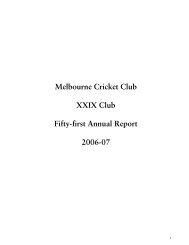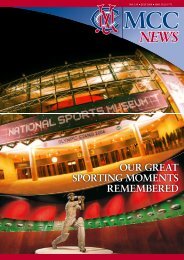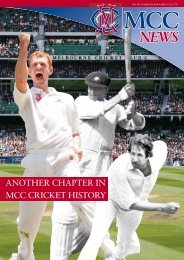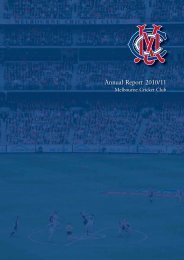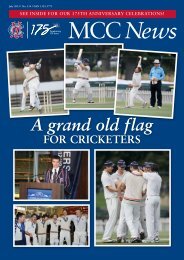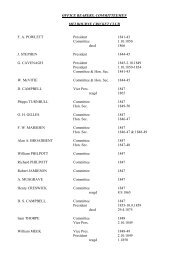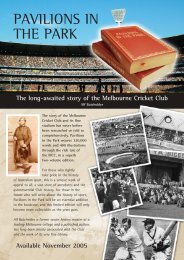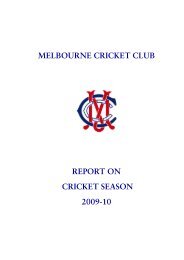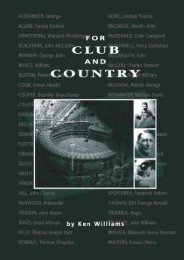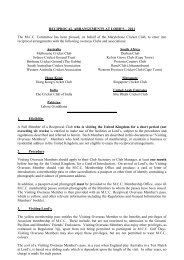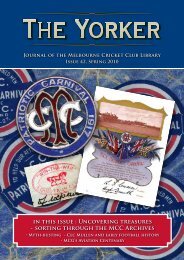Issue 36: Summer 2006/07 - Melbourne Cricket Club
Issue 36: Summer 2006/07 - Melbourne Cricket Club
Issue 36: Summer 2006/07 - Melbourne Cricket Club
You also want an ePaper? Increase the reach of your titles
YUMPU automatically turns print PDFs into web optimized ePapers that Google loves.
Thompson, HarryPenguins Stopped Play:Eleven Village <strong>Cricket</strong>erstake on the World.John Murray (Publishers):London, <strong>2006</strong>ISBN <strong>07</strong>195 6345 3This is a delightfully entertaining book which I consumed whilewatching our Ashes heroes strut their stuff recently on thebeautiful Adelaide Oval. It is the story of the life and times of theCaptain Scott Invitation XI, a village green cricket team whichbegan life among a group of students at Oxford University.The team continued to play both at home and abroad over a25-year period and at one stage did a whirlwind three-week roundthe world tour to enable it to play on all continents.The author was a storyteller. His story highlights the eccentricityof the British and the bulldog-like tenacity which served themwell during their round the world trip when everything that couldgo wrong generally did! It is at times Monty Pythonesque witha tinge of the Goons. Some of the characters in and aroundthe team are a delight. How could one come to be travellingin Uzbekistan with a full set of Wisdens and then lose them?Hugh Grant (alias Captain Peacock of BBC fame) was a teammember as were the O’Herlihy brothers, lawyers of part Irish/partMalaysian extraction who played in shades and ponytails. Thebrothers did not excel at cricket but were invaluable in “tightcorners on far-flung fields”. One of the four however paid lipservice to his responsibilities, preferring to spend the weekend inbed with his Swedish girlfriend rather than immersing himself inthe raw pulsations of village green cricket. Then there were thestockbrokers in their Gucci pads……...!Thompson was, from time to time during his working life, a traveljournalist. His writings on the team’s travels and his impressionsof places visited are informative, witty and stylish.This may not be one for the connoisseur or the cricket tragic orthose who thirst after accounts of the exploits of the elite playersand immerse themselves in voluminous servings of statistics. Itis escapism, well presented and entertaining. Sadly, the authordied soon after finishing the book. He may well have finished hisfinal story under threat from the illness which took his life.Ross PerryHaigh, Gideon.The <strong>Summer</strong> game: <strong>Cricket</strong> andAustralia in the 50s and 60s.ABC Books & Audio, <strong>2006</strong>.ISBN : 978<strong>07</strong>33320033ABC Books have just reissued an updated edition of GideonHaigh’s The <strong>Summer</strong> Game to coincide with the release of their<strong>Cricket</strong> in the 50s and <strong>Cricket</strong> in the 60s DVDs.The editors did not think they could improve upon Ross Peacock’sreview of the original edition, published in The Yorker No.16, sowe are reprinting that for your enjoyment.This is clearly the best cricket book that I have reviewed in thefour-year history of The Yorker.It really amazes me that its author, Gideon Haigh, is only 31years of age and continues to provide more graphic and colourfulwriting than many of the other more “mature” cricket scribes.What is more, Haigh is talking in this book about an era throughwhich he did not, for the most part, live. To find Gordon Rorke(of the late ‘50s and early ‘60s) described as “husky” recalls mymental image of the NSW paceman in the most vivid manner. Sotoo the image of Ken “Slasher” Mackay, “a man with an allegianceto Wrigley’s gum so unstinting that he stockpiled enough to lastthe tour.”The author’s use of evocative language is again demonstratedin a sentence discussing the Third Test, Australia v South Africa,at Durban in 1950 when Neil Harvey made 151 not out. Harveyhad to graft for his runs: “So used to dictating terms to bowlers,Harvey found the experience disorienting. It was taking so long.He was actually practising, and counselling, caution.” Ratherthan just describing the “play” or giving “the scores”, Haigh digsdeeper and deeper into the psyche of Australian cricket at homeand abroad and, largely through new material gained by oralinterview, paints a picture of what it was really like to playTest cricket.Who drank with whom and why, and who didn’t. The tradesor professions of the players, and how these impinged onmany career directions; the state of the economy and thecontribution of cricket to it; the pressures of raising a familyand staying in cricket.For this is definitely also a social, economic and political history,throwing new light, for instance, on the love of cricket held by SirRobert Menzies and just how much he would do for anyone who“played the game” to his liking. Before the Test matches startedon the 1953 tour of England, Menzies threw a huge dinner in theRiver Room of the Savoy Hotel, London. No expense was spared,including steaks shipped over from Australia for the occasion.The PM recited a 23-verse poem as an ode to the Aussies, thepoem appearing in full in the appendix. Health and fitness is alsoan ongoing issue in the book, from the temporary vegetarianismof Frank Misson to the ill-health suffered by a large number ofplayers such as Lindsay Kline and Alan Connolly when touringthe subcontinent.The <strong>Melbourne</strong> <strong>Cricket</strong> <strong>Club</strong> gets some attention too, and thealleged “watering of the wicket” incident in the 1955 <strong>Melbourne</strong>Test is aired, partly through the testament of Ian Johnson who ayear later became MCC secretary.Altogether a book which I could not put down, and would fullyrecommend to any Australian History class.Ross Peacock10The Yorker - <strong>Summer</strong> <strong>2006</strong>/<strong>07</strong>



